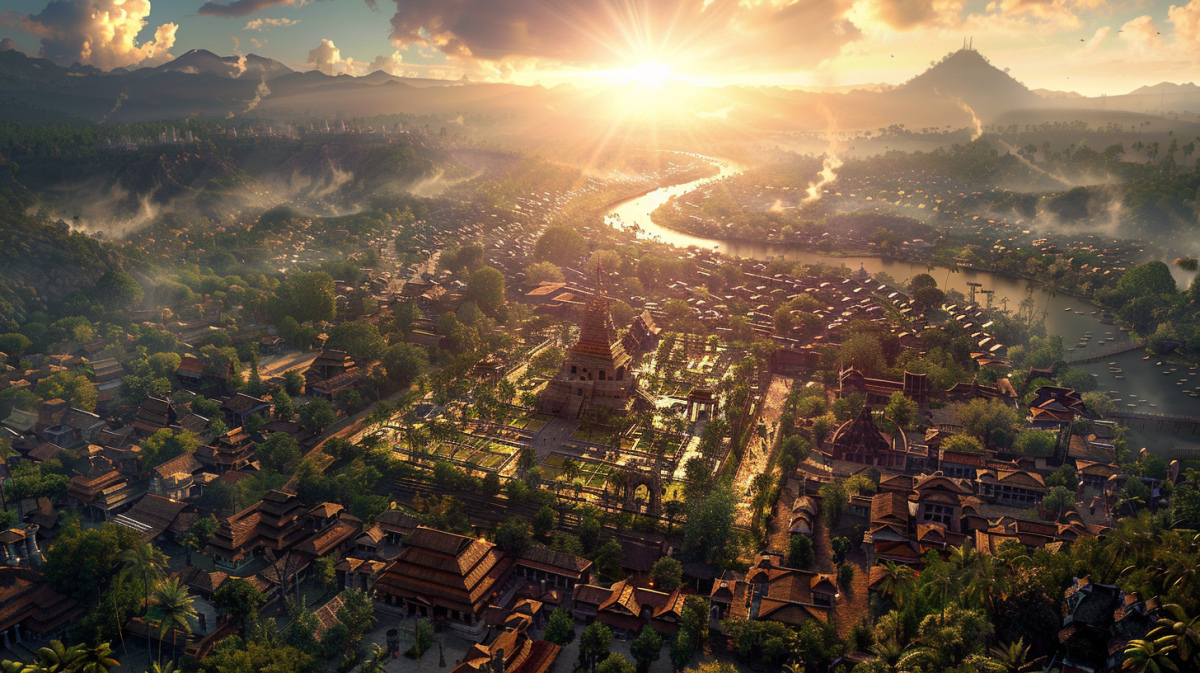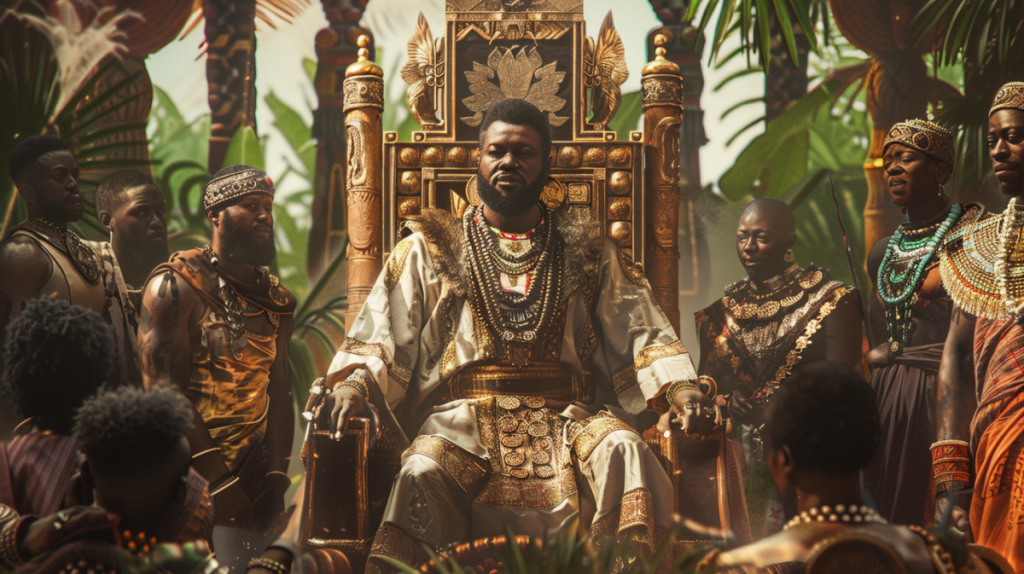The Kingdom of Kongo, in present-day Angola and DR Congo, peaked between the 14th and 17th centuries. Engaging in trade with the Portuguese, they adopted Christianity early on. The kingdom’s decline began in the late 17th century due to internal strife and European influence.
Introducing the Kingdom of Kongo
The Kingdom of Kongo was one of the largest African kingdoms and occupied the Republic of Congo, the west of the Democratic Republic of Congo and northern Angola. At its peak, the kingdom of Kongo spanned from the Atlantic Ocean, stretching to the Congo River, the Quango River and the Kwanza River.

Origins of the Kingdom of Kongo
The origins of the Kingdom of Kongo started from the decline of the ancient Bangu kingdom which was based north of the Congo River.
Bantu-speaking people from the Benue River area migrated into the Uele and Bas-Congo (Kongo central) regions around 1000 BC. They were the first known migrants in the area once occupied by the Kingdom of Kongo. They were followed by waves of Nilotic-speaking migrants from the southern and central regions of Sudan, as well as groups (mainly cattle herders) from East Africa who eventually settled around the Great Lakes area.
These migrants occupied an area that is now within the borders of Angola, Democratic Republic of Congo, Republic of Congo and (to a certain extent) Southern Gabon.
The Bantu-speaking peoples brought with them their knowledge of metallurgy and agriculture. The mighty Congo River and its tributaries run through the fertile area, allowing the new settlers to grow yams, sorghums, millet, oil palms and vegetables. Their ability in making iron tools allowed them to grow more crops. With an abundance of food, it was not long before their population increased.
As the years passed, most of the people who lived in the area spoke a Bantu language called Kikongo. What made the ancient Kongolese society unique was their matrilineal descent system (children inherited their ranks and properties through their mothers). Their simple villages and towns soon turned into mini-states (wene) ruled by chieftains or clan heads.
The Birth of the Kingdom of Kongo
The Kingdom of Kongo begins with the marriage of Nima a Nzima to Luqueni Luansanze, the daughter of Nsa-cu-clau, the chief of the Mbata people. Their marriage would solidify the alliance between the Mpemba Kasi and the neighbouring Mbata people, an alliance which would become the foundation of the Kingdom of Kongo. Nima a Nzima and Luqueni Luansanze had a child named Lukemi Lua Nimi, who would become the first person to take the title of Mutinu (King). Lukemi Lua Nimi is presumed to have been born between 1367-1402 CE.
It is estimated that the core of the kingdom began in the province of Mpemba Kasi in the south of Kongo and that Lukemi Lua Nimi built the capital city of Mbanza Kongo which is now Northern Angola.

Despite being one of the largest kingdoms in Africa, the expansion of the kingdom was achieved without military conquests. The kingdom did not have an organised army, there were royal guards who were strong men who were chosen to protect the elderly, children, and women and watch over the Kingdom’s borders. The royal guards also protected the royal court and executed the king’s orders.
The royal guards were not mercenaries or slaves, they were called “Bana Ba Nazo” which meant “children of the house”. This is because they have been under the care of the royal court since childhood as they were taken from their families or orphans.
The kingdom of Kongo expanded without an army because surrounding kingdoms were free to choose to become part of the kingdom and became provinces as long as they agreed, committed, respected and followed the established laws. The provinces had the choice to leave the kingdom without any resistance or retaliation from the central government. This method of governance could possibly explain why there was little or no resistance when the Europeans invaded the kingdom.
The Kingdom of Kongo was estimated to have around 3 million subjects in total. The kingdom is believed to have had 6 kings (including Nima a Nzima, despite never taking the title of the king before 1490).
At its peak in the 15th and 16th century CE, the kingdom controlled some 240km (150 miles) of the coast from the Congo River in the north to just short of the Cuanza River in the south and spread some 400 km (250 miles) into the interior of Central Africa up to the Kwango River.
Political Structure of the Kingdom of Kongo
The king had a council of 12 wise advisers who were nominated for life in the royal court. The 12 advisers had the power to dethrone the king due to misconduct or inability to lead the kingdom. The king’s role was described to be the servant of the people, maintaining cosmic and social order and helping prosperous members of the community to live humbly. The king ensured equity amongst the Baking and was respected and represented in provinces by governors. The kingdom had 12 provinces which were governed by 12 governors who were chosen by the king. The provinces were:
- Mbata
- Mpemba
- Mpangu
- Ndongo
- Nsundi
- Matamba
- Mbamba
- Soyo
- Mpumbu
- Loango
- Kokomo
- Ngoyo
Electing a new king
Any citizen of the Kingdom of Kongo could be a king. Following the death of the king, the king’s death was announced to the kingdom’s provinces. The provinces would then prepare their candidates. Months, sometimes years could pass until a new king was chosen. The council of the 12 wise men ruled the kingdom until a new king was elected.
Candidates for kingship would submit their proposals for the role to a council of 12 wise men in their provinces. Each council of the provinces will choose the best candidate to present to the 12 wise men in Mbanza, the capital of the kingdom. The chosen candidates would take part in an oral examination in front of a large council which consisted of the 12 wise counsellors of Mbanza and the 12 governors of the provinces.
Two candidates were then chosen as the finalists and the 12 governors and the 12 wise men of Mbanza chose an election day. On election day, the king was elected by the 12 counsellors of Mbanza through the raising of hands. Once the new king has been elected, the 12 governors resigned and waited for the king to replace or reassign them. The citizens of Mbanza were invited to see the new king and the eldest member of the counsellors went on a podium to present the new king.
The Kingdom of Kongo had a unique custom. A position was given to all 12 chosen candidates for kingship. The finalists became citizens of Mbanza and never returned to their provinces. All 12 candidates were given a noble title such as Mani. This title was used to distinguish a king or someone with authority. Another title which was also used as Ne. The title the candidates were given was followed by the name of their province, district or function (for those who had positions in the royal court). For example, Mani Matamba was the Mani of Matamba.
Trade, Technology and Education of the Kingdom of Kongo
Citizens of the kingdom engaged in breeding, hunting and agriculture. They learned a trade of their choice and enrolled on a prestigious school. The most famous schools were Buelo, Kinkimba, Lemba and Kimpasi. These prestigious schools were there to train the elites of the kingdom. Enrolment was open to any member of the society but the students had to participate in the initiation ceremonies which had strict criteria for selection.
The kingdom prospered thanks to the trade in ivory, copper, salt and cattle hides. The kingdom produced its own goods via specialised groups of craftworkers such as weavers (who produced the famous raffia fabrics of Kongo), potters and metalworkers who melted gold and copper. The Kingdom of Kongo had a large commercial network and became the centre of trade routes for pottery, ivory, copper and raffia cloth.
The level of trade conducted between the forest and grassland peoples of west-central Africa is indicated by the established use of a shell currency, the spiral nzimbu shells which originally came from Luanda, an offshore island located 240 km away. Initially used as a means of storing wealth and as a standard measure of the value of other goods, the shells came to be used like coins to pay for goods and labour. Not having the regions trade all to themselves, rival equatorial African kingdoms included Loango and Tio, both located to the North of Kongo and the loose confederation of tribes of Ndongo to the south (modern Angola).
Related Posts
Sources
Bostoen, Koen and Inge Brinkman. The Kongo Kingdom: The Origins, Dynamics and Cosmopolitan Culture of an African Polity. Cambridge University Press, 2018.
Encyclopedia Britannica. “Kongo.” Encyclopedia Britannica, Encyclopedia Britannica, Inc., 19 Aug. 2016, https://www.britannica.com/place/Kongo-historical-kingdom-Africa.
The New York Public Library. “The Unsung History of the Kingdom of Kongo.” The New York Public Library, The New York Public Library, 2 Nov. 2021, https://www.nypl.org/blog/2021/11/02/unsung-history-kingdom-kongo.
World History Encyclopedia. “Kingdom of Kongo.” World History Encyclopedia, World History Encyclopedia, 27 Feb. 2019, https://www.worldhistory.org/Kingdom_of_Kongo/.





